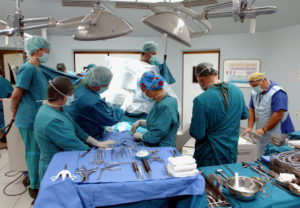As hospitals upgrade their existing life safety systems to include newer technology, designers of record may not be sure of where notification devices should be placed, given the need for quiet areas in a hospital. Since this is a non-evacuation occupancy, private mode signaling can be used for fire alarm announcements, as allowed by NFPA 101 (2012) Chap. 9.6.3.6.3:
“ Where occupants are incapable of evacuating themselves because of age, physical or mental disabilities, or physical restraint, the private operating mode, as described in NFPA 72, National Fire Alarm and Signaling Code, shall be permitted to be used. Only the attendants and other personnel required to evacuate occupants from a zone, area, floor, or building shall be required to be notified. The notification shall include means to readily identify the zone, area, floor, or building in need of evacuation.”
The location of these devices are generally at nurse stations, back of the house areas, in corridors at stairwells, etc. Additionally, beyond the selective notification allowed in NFPA 101, fire alarm signal audibility requirements are lowered as well. Per NFPA 72 (2010) Chap. 18.4.4.1, private operating mode only requires 10 dB over ambient sound levels in those areas where appropriate staff notification is required:
“To ensure that audible private mode signals are clearly heard, they shall have a sound level at least 10 dB above the average ambient sound level or 5 dB above the maximum sound level having a duration of at least 60 seconds, whichever is greater, measured 5 ft. (1.5 m) above the floor in the area required to be served by the system using the A-weighted scale (dBA).”
That’s 10 dB above ambient in the areas where responding staff are normally found, not 10 dB over ambient in the entire hospital. One more consideration from NFPA 72 Chap. 18.4.4.2 allows the elimination of audible signals in AHJ approved areas when visual signaling is provided.
“Where approved by the authority having jurisdiction or other governing codes or standards, the requirements for audible signaling shall be permitted to be reduced or eliminated when visible signaling is provided in accordance with Section 18.5.”
In other words, if you would normally place a chime/strobe or a speaker/strobe at a nurse station in NICU, but there are concerns about causing patient distress due to the sound/message, a strobe can be installed instead, provided the AHJ is OK with it. The AHJ can also approve the complete elimination of notification in critical care areas (such as surgery rooms), since responding staff aren’t normally present and their activation may do more harm than good. The key to remember is that in private operating mode, the intent is to not alarm the general public (or surgeons), only to notify specific staff members in order to respond to the event per internal procedures.
Affiliated Fire Systems has installed life safety systems in many hospitals and other healthcare facilities. We have the expertise and equipment to help you manage your life safety needs in a cost effective and code compliant way. Be sure to check our website for more information on our Gamewell-FCI E3 life safety system.
Gene Rowe
Affiliated Fire Systems, Downers Grove, IL



Send us a Comment